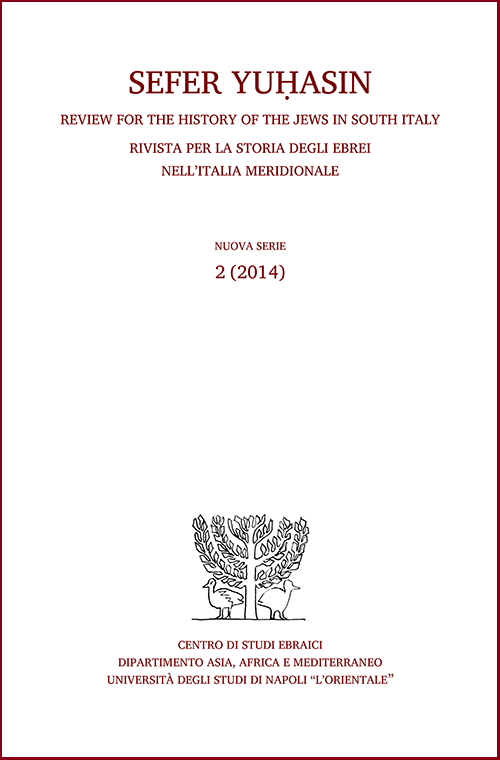A proposito dell’iscrizione sepolcrale ebraico-latina di Anna figlia di Rabbi Giuliu da Oria
Abstract
In questo studio si presenta un riesame dell'epigrafe funeraria di Anna, figlia di Rabbi Giuliu di Oria, su cui si sono impegnati vari studiosi, dal glottologo ed epigrafista goriziano Graziadio Isaia Ascoli a Jean-Baptiste Frey, Cesare Colafemmina, David Noy, Giancarlo Lacerenza. Se ne propone qui una datazione anteriore all'VIII secolo, data sostenuta più recentemente, sulla base di una possibile lettura di šnptrh e di alcune incisioni appena visibili sulla superficie dell'iscrizione, che sembrerebbero indicare l'anno 605 dalla distruzione del Tempio, corrispondente al 673 dell'era cristiana. Questa nuova datazione sembra corroborata dall'analisi paleografica e dal confronto dell'epigrafe con altri materiali coevi.
On the Hebrew-Latin Epitaph of Anna, Daughter of Rabbi Giuliu from Oria
In this study the author tries to solve the puzzling line 8 in the epitaph of Anna, the daughter of Rabbi Giuliu, discovered in Oria in the 19th century. Many scholars have already engaged in the examination of this epitaph since 1880, when epigraphist and linguist Graziadio Isaia Ascoli published the Hebrew text for the first time, presenting his reading of which he himself was not very confident. The crux interpretum concerns in particular the interpretation of the date of the maṣevah. The complicated and unconvincing reading proposed by Ascoli was already corrected by some reviewers of his well-known study on the Jewish inscriptions of Southern Italy, i.e., J. Derenbourg, D. Chwolson, Th. Mommsen and H.P. Chajes, in the period spanning from the years 1881 to 1910. Then the epigraph was published by Jean-Baptiste Frey, who argued that, since there is also a part in Latin, the text could not be dated later than the 7th century. In 1953, E.R. Goodenough proposed to date it even earlier than suggested by Frey. Cesare Colafemmina worked on the text from 1973 until 2012, but basically he followed the reading accepted by the epigraphists after Ascoli, dating it to the 8th century, also on the basis of a suggestion by Vittore Colorni. In 1993 David Noy, following Colafemmina, disagreed with Frey and most recently, in 2014, only Giancarlo Lacerenza, even if offering the traditional date of 8th century, adds a question mark, considering it perhaps to be older. In the re-examination of the text proposed here, the Author, on the basis of a possible reading of the letters š-n-p-t-r-h and some slight signs of graffiti barely readable on the surface of the stele – carved as a draft for the stonecutter – proposes to read the date as 605 from the destruction of the Temple, equivalent to the year 673 of the Christian Era. This new interpretation seems to be supported also by a palaeographic examination of the epigraph, compared with other contemporary examples.
Downloads
Gli autori che pubblicano su questa rivista accettano le seguenti condizioni:
- Gli autori mantengono i diritti sulla loro opera e cedono alla rivista il diritto di prima pubblicazione dell'opera, contemporaneamente licenziata sotto una Licenza Creative Commons - Attribuzione che permette ad altri di condividere l'opera indicando la paternità intellettuale e la prima pubblicazione su questa rivista.
- Gli autori possono aderire ad altri accordi di licenza non esclusiva per la distribuzione della versione dell'opera pubblicata (es. depositarla in un archivio istituzionale o pubblicarla in una monografia), a patto di indicare che la prima pubblicazione è avvenuta su questa rivista.
- Gli autori possono diffondere la loro opera online (es. in repository istituzionali o nel loro sito web) prima e durante il processo di submission, poiché può portare a scambi produttivi e aumentare le citazioni dell'opera pubblicata (Vedi The Effect of Open Access).

